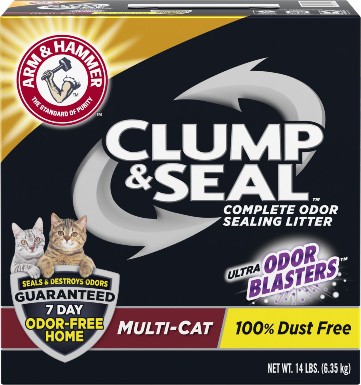Click to Skip Ahead
Owning a cat means accepting the fact that you have to clean up after them. And while no one loves to clean the litter box, we do love our whiskered, four-legged friends. An essential part of keeping a litter box in your home is choosing the right litter, which can make a difference in how your cat uses the litter box as well as how a litter box affects your home.
We want our cats to feel comfortable and have a place to use the bathroom that feels natural. But with so many different types of cat litter, it can be frustrating to find one that works for both of you. After all, if your cat rejects the litter box, you may have a bigger mess to to clean up.
Two of the all-around best types of cat litter seem to be wood pellets and clumping cat litter. Both have their own advantages and disadvantages. If you’re trying to decide between the two, we’ll look at both of them in this article so that you can choose one that works for your cat.
Overview of Wood Pellets
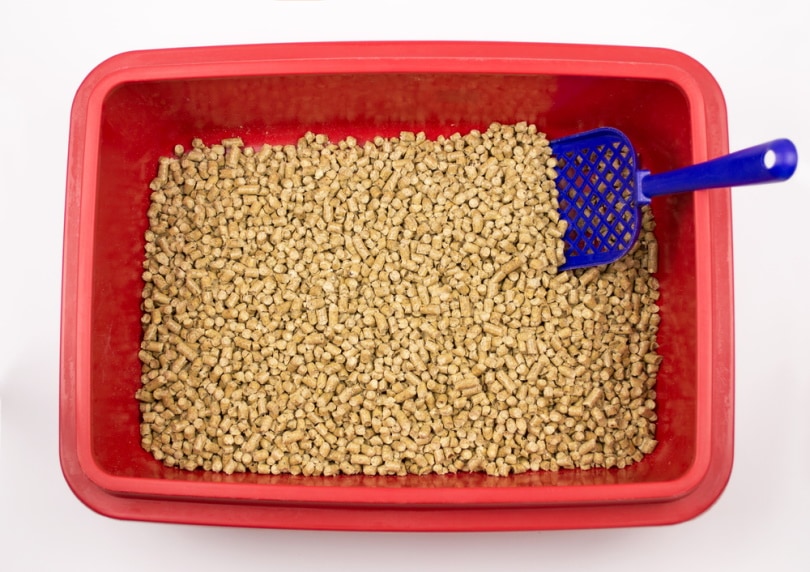
Wood pellet cat litter is just like it sounds. It is made from pellets of wood, most commonly pine. Other types of wood can be used, but pine wood has a natural scent that’s good for masking odors without chemical additives.
This type of cat litter has become more common to use as pet owners seek to make more eco-conscious decisions. Wood pellets are biodegradable and often made from recycled materials. They can also last a lot longer than traditional clay litter, so you don’t have to change it as often.
How It Works
Wood is a highly absorbent material, which is what makes wood pellets an effective cat litter. It works like other types of cat litter by absorbing the liquid from urine. When the urine is absorbed, the odor is neutralized.
When urine is absorbed, the pellets turn to sawdust. The sawdust settles to the bottom of the litter pan and leaves behind fresh pellets on top. The natural pine fragrance of the litter helps to mask that smell.
How to Clean & Change It
Wood pellet litter should be scooped once per day and completely changed once every two weeks. Daily cleaning is a two-step process. First, use a traditional cat scoop to first remove the solids. Next, scoop out piles of sawdust and sift the scooper so that dry pellets don’t get disposed of as well. Lastly, put the dry pellets back into the box and top with a fresh layer of pellets.
Although it’s recommended to replace the entire contents of the litter box with fresh pellets every two weeks, you might get away with doing it less often if you scoop it every day. If you have more than one cat, you may have to completely change the litter more frequently.
To make your litter-changing experience easier, you can also purchase a litter box that has a built-in sifter tray. This way, the sawdust will filter through the sifter. All you have to do is remove the solids and empty the bottom tray of sawdust.
Even if you keep a clean and tidy litterbox, you probably still find yourself with cat odors and stains around the house – but with the Hepper Advanced Bio-Enzyme Pet Stain & Odor Eliminator Spray, you can permanently remove even the very worst pet stains and smells! Click here to learn more and get yourself a bottle.
- ADVANCED ENZYMATIC CLEANER - Penetrates the most stubborn smells and stains at the deepest molecular...
- FOR ANY MESS, ON ANY SURFACE - This pet odor eliminator cleans your carpets, floors, furniture,...
- FRESH, NATURAL ODOR - Our unique formulation doesn't rely on dangerous or unpleasant chemical...
At Pet Keen, we’ve admired Hepper for many years, and decided to take a controlling ownership interest so that we could benefit from the outstanding products of this cool cat company!
How to Dispose of It
Wood pellets are made from natural materials, so they are biodegradable and can also be composted. You should be careful when composting, however, as cat feces contains parasites that can cause toxoplasmosis in humans.
Keep a separate compost pile for wood pellet litter and don’t use that pile on vegetables and other edible plants. If you don’t compost, you can also flush the litter in small amounts or just throw it away.
Overview of Clumping Cat Litter
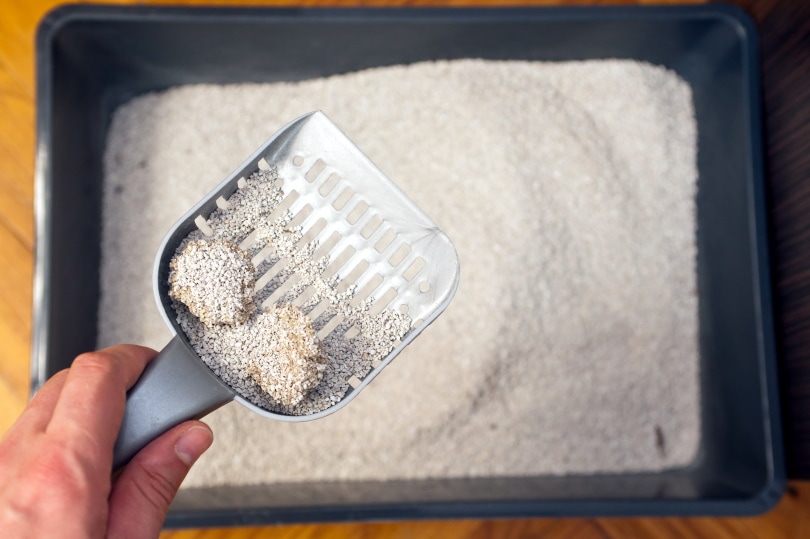
The clumping cat litter is a variation of the original type of clay cat litter. It is made from small particles of different types of clay that stick together when exposed to moisture. The clumping action allows cat owners to remove some of the used litter without having to empty out the whole litter box.
However, this type of cat litter isn’t naturally scented. You can purchase it in unscented varieties, but it can cause your home to be filled with unpleasant odors. Because of this, scented versions are available, but they are fragranced with artificial, chemical scents. Clumping litter isn’t usually rejected among cats because it feels like a more natural place to relieve themselves.
How It Works
Clumping cat litter is primarily made from small particles of bentonite clay. When exposed to liquids, the bentonite clay particles absorb the moisture and stick together, hence the name “clumping” cat litter. This is many people’s preferred type of cat litter because it is so easy and convenient to clean.
When the litter box is cleaned, you can simply scoop out the clumps while loose litter will sift through the scoop and back into the litter box. You don’t have to have a special type of litter box or scoop. It does produce some dust when cleaning it. However, even with regular cleaning, clumping litter can last for a long time.
How to Change It
The process for changing clumping litter is not that different from changing wood pellet litter. The biggest difference is that it’s much faster to sift and remove clumping litter when scooping because not all of the clumps settle to the bottom. If you have multiple cats, clumping litter should be scooped daily. If you only have one cat, you could probably get away with doing it every other day.
To scoop clumping litter, you’ll just need to remove the clumps with the scoop. You should be able to feel the clumps as you’re scooping. When you remove a clump, shake the scoop over the box to remove any loose litter. Dump the clumps of litter into a bag and continue until only loose litter remains.
Every 2 weeks, the litter box should be completely emptied, cleaned, and replaced with clean litter. To change the litter, dump the entire contents of the box into a bag. Because clumping litter sticks together, it can leave behind a mess in the bottom of the box. Spray the litter box down with soap and water. Then rinse it off, dry it, and add fresh, clean litter.
How to Dispose of It
Clumping litter can potentially cause harm to the environment due to some of the chemicals found in it. It should not be composted or flushed. Instead, the bag that you dumped the used litter in should be tossed into your trash can with the rest of your trash.
Other Things to Consider

Price
A key factor when purchasing any product is price, and cat litter is no exception. Wood pellets tend to be cheaper Clumping litter costs more due to being made from clay, and you also have to consider the convenience of being easy to scoop.
Higher-quality cat litter will also cost more, regardless of whether it is wood pellets or clumping. Good cat litter will absorb liquids and odors effectively in addition to lasting a long time. When choosing, you’ll have to consider whether or not you want to put forth the extra cost to get a high-quality litter and you may have to try out several different kinds before finding one that works for you and your cat.
Safety
Another factor to consider when choosing a cat litter is safety. Although clumping litter is convenient, there are some safety concerns that come with it. For starters, the bentonite clay in clumping litter may cause problems for your cat if they ingest it. It can interfere with digestion by causing blockages in their stomach and intestine as it absorbs some of the liquids found inside their body. This may not be a cause for concern if you haven’t noticed your cat eating litter. But if you have, then clumping litter may not be the best option for your cat.
Another concern is the potential hazards to humans. Your cat can’t clean their own litter box, which leaves that job up to you. Due to the toxoplasmosis found in cat litter, it can be dangerous for pregnant women to scoop litter of any kind. But even if you aren’t pregnant, the dust caused by clumping cat litter can cause respiratory irritation, especially in litters that are scented with artificial fragrances. If you have any respiratory illnesses, then wood pellets may be the better option.
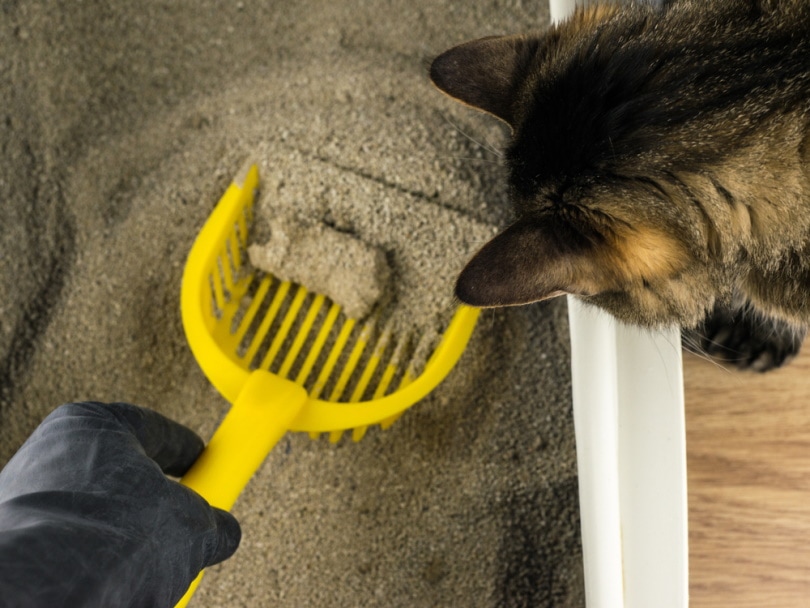
What to Look for When Switching Litter
If you’ve used a different type of litter before and are making a switch, there are certain things you need to look for in order to make sure the new litter is safe and effective for your cat. For starters, cats can suffer from allergies and skin sensitivities just like humans can.
With either type of litter, you’ll want to look for signs of an allergic reaction, including any respiratory problems or skin irritation. This is especially true for fragranced litter, but even wood pellets can pose a problem for some cats. Discontinue using the litter if it is causing problems for your cat.
You may also want to monitor your cat’s litter box habits for a few days after switching litter. With wood pellets especially, some cats may not like the texture of it if it isn’t what they’re used to. They may start relieving themselves in other places as a result, leaving you with more unpleasant messes to clean up. Some cats take longer than others to warm up to the idea of new litter, while others may not warm up to it at all.
| Characteristics of Wood Pellet Litter | Characteristics of Clumping Litter |
| Made from wood | Made from bentonite clay |
| Chemical-free, natural litter | Contains chemicals and artificial fragrances |
| Compostable | Throw away |
| Absorbent | Absorbent |
| Some cats may reject it | Most cats will use it |
Quick Look: Our Top Choices
| Image | Product | Details | |
|---|---|---|---|
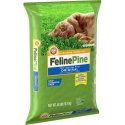
|
Feline Pine Wood Cat Litter |
|
Check Price |

|
Arm & Hammer Clump & Seal Litter |
|
Check Price |
Our Favorite Wood Pellet Cat Litter
Feline Pine Original Non-Clumping Wood Cat Litter
This wood pellet cat litter is made with pine fibers, which will keep those smelly litter box odors in check and make your house smell naturally fresh at the same time. It is also free of chemicals so that your pet stays safe when using the litter box and you stay safe while cleaning it. Being made from wood pellets means that there will be no dust cloud left behind either when cleaning and pouring fresh litter.
Our Favorite Clumping Cat Litter
Arm & Hammer Litter Clump & Seal Cat Litter
This clumping cat litter is designed for multi-cat homes but works just as well in single-cat homes too (and you won’t have to change it as often). Baking soda in the formula helps to absorb odors. The litter will offer odor protection for up to seven days. It is also dust-free, unlike other clumping cat litters, so you don’t have to worry about breathing in any unpleasantness when you scoop and clean the litter box.
Conclusion
When choosing cat litter, it is important to make an informed decision to ensure that it works for both you and your cat. Wood pellets are cheaper and more environmentally friendly, but clumping litter tends to do a better job at controlling odors in addition to being more convenient to clean. However, it also produces dust and is more expensive. The decision ultimately comes down to what you’re comfortable with paying for and cleaning, and most importantly, what your cat will actually use.
Featured Image Credit: Left – Alla_vector, Shutterstock; Right – borzywoj, Shutterstock






